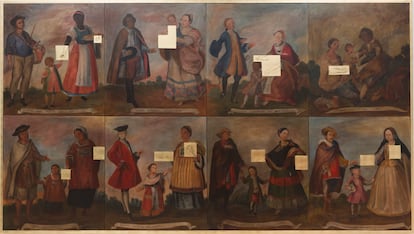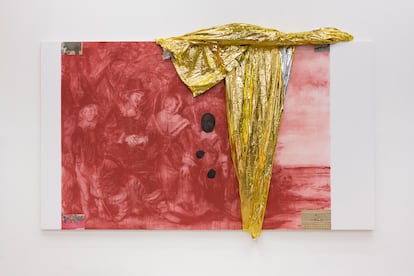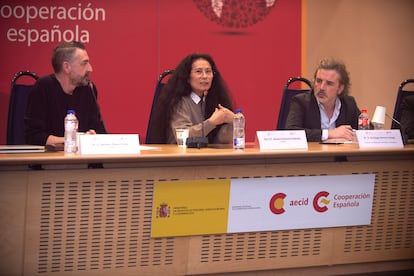Spain starts decolonizing its art at the Venice Biennial
Peruvian Sandra Gamarra is the first artist not born in Spain to represent the country in the world’s oldest international contemporary art exhibition with the project ‘Pinacoteca migrante’

Peruvian Sandra Gamarra is to represent Spain at the 60th Venice Biennale contemporary art exhibition opening on April 20 until November 24, making her the first artist born outside the country to do so.
Her body of work is called Pinacoteca migrante, which questions colonial narratives and traditional modes of representation, as announced Wednesday, February 14. Her presentation follows the Minister of Culture Ernest Urtasun’s announcement on January 22 that there would be a revision of state museum collections to “overcome a colonial framework.” While not directly related, both are signs that Spain is joining a movement sweeping the West, which began some years ago in other parts of Europe and the U.S.
“I will never forget one of my first visits to the Archaeological Museum [in Madrid],” said Gamarra who grew up in Lima but has lived in Spain for 20 years. “After seeing the rooms dedicated to four continents, I asked the guard which floor Europe was on and he told me that was history and belonged in other museums.”
With Pinacoteca migrante, Gamarra will transform the Spanish pavilion at the Biennale into a space where Spain’s artistic heritage — Murillo, Zurbarán and even Velázquez — can be reinterpreted while drawing attention to silenced cultures. “Decolonization begins with putting an end to the hierarchies of cultures that place some above others,” Gamarra, 52, told EL PAÍS. “That is the start and from there we can begin to rewrite all aspects of those relationships, not only the cultural one.”
Gamarra, who participated in the 2009 Venice Biennale in the Italian-Latin American Institute’s pavilion, takes paintings from the time of the Empire to the Enlightenment as her point of departure, in which reference is made to the territories that were part of Spain, but which carry a “monolithic notion based on the destruction of other forms of social organization.” Divided into six sections, her work will include classic artistic genres such as engraving, portrait and landscape with interventions and reinterpretations that will analyze the biased representations that exist between the colonizers and colonized, besides offering a historical context linked to the present.
“Our vision of art tends to isolate the artistic object from its surroundings, and in that separation a lot of information is lost,” she explains. “The very idea that art has to lead you to a contemplation is a paradigm that we can break, because that same state of contemplation is dependent on labor, extraction, a whole structure. All that information must be permeable and porous in museums.”

The rooms that make up Pinacoteca migrante are titled: Virgin Land, which includes landscapes from Spain, and also Latin America, the Philippines and North Africa; Cabinet of extinction, which links colonialism to extractivism; Cabinet of Illustrated Racism, which tells the story of how anthropology and science were used as a tool for racial discrimination; Mestizo Masks, which is a portrait of colonists; Altarpiece of Dying Nature, which links still life with the construction of opulence and treasures; and Migrant Garden, which will recreate monuments to conquest that are located in the former colonies. All of them will combine plastic arts with quotations from writers and ecofeminist thinkers; and modified copies of illustrations from real archives with representations of allochthonous or invasive plants as an allusion to migration.
The idea, Gamarra says, is to get rid of the “monotheistic bug” that inhabits every museum where visitors seek “to find the only truth they believe to be true.” Gamarra’s project is being curated by Agustín Pérez Rubio, who has had an extensive career in Latin America as artistic director of the Buenos Aires Museum of Latin American Art — the Malba — and as curator of the Chilean pavilion at the 2018 Biennial.
“This pavilion shows a modern-day Spain, where I think 15% are Latin Americans, a progressive, open Spain that seeks equality,” says Santiago Herrero, director of Cultural and Scientific Relations at the Spanish Agency for International Cooperation for Development (Aecid), attached to the Ministry of Foreign Affairs, European Union and Cooperation, which is in charge of choosing which artist will represent Spain at the Biennial. The selection is done by a jury made up of representatives from institutions such as Barcelona’s Museum of Contemporary Art, (Macba), and the Valencian Institute of Modern Art (IVAM), among others. This year, the jury was unanimous in their choice of Gamarra’s Pinacoteca migrant. And while Herrero stresses that the choice had nothing to do with the Culture Minister’s announcement to revise state museum collections, he acknowledges that decolonization and the integration of other narratives is a current trend, illustrated by the theme of this year’s Biennial: foreigners everywhere.

Regarding critical reactions to the Culture Minister’s decision to review state museum collections, Valencian vice president Vicente Barrera from the ultra-right Vox party, accused Urtasun of “buying the black legend of Spain.” Gamarra has a different perspective: “My school was run by Spanish nuns,” she says. “When we already had a conscience and were studying the conquest, the teacher began to provide details of the genocide. There was a moment of awkward silence and we all looked at the nun, who said, ‘but we brought religion.’ It was like a source of relief for her, making her think that she would no longer go to hell. Precisely those ideas highlight hierarchies — ‘we brought culture because there was no culture, or it was bad culture. I have already rewarded you, why are you complaining,’ as if there was nothing to complain about.”
Sign up for our weekly newsletter to get more English-language news coverage from EL PAÍS USA Edition
Tu suscripción se está usando en otro dispositivo
¿Quieres añadir otro usuario a tu suscripción?
Si continúas leyendo en este dispositivo, no se podrá leer en el otro.
FlechaTu suscripción se está usando en otro dispositivo y solo puedes acceder a EL PAÍS desde un dispositivo a la vez.
Si quieres compartir tu cuenta, cambia tu suscripción a la modalidad Premium, así podrás añadir otro usuario. Cada uno accederá con su propia cuenta de email, lo que os permitirá personalizar vuestra experiencia en EL PAÍS.
¿Tienes una suscripción de empresa? Accede aquí para contratar más cuentas.
En el caso de no saber quién está usando tu cuenta, te recomendamos cambiar tu contraseña aquí.
Si decides continuar compartiendo tu cuenta, este mensaje se mostrará en tu dispositivo y en el de la otra persona que está usando tu cuenta de forma indefinida, afectando a tu experiencia de lectura. Puedes consultar aquí los términos y condiciones de la suscripción digital.
More information
Archived In
Últimas noticias
Most viewed
- Reinhard Genzel, Nobel laureate in physics: ‘One-minute videos will never give you the truth’
- Pablo Escobar’s hippos: A serious environmental problem, 40 years on
- Charles Dubouloz, mountaineering star, retires at 36 with a farewell tour inspired by Walter Bonatti
- Why we lost the habit of sleeping in two segments and how that changed our sense of time
- The fall of a prolific science journal exposes the billion-dollar profits of scientific publishing











































